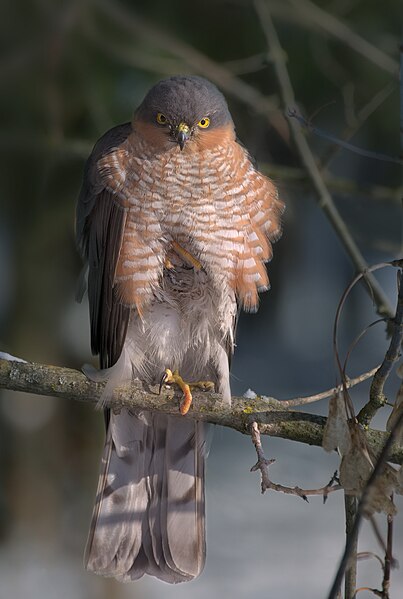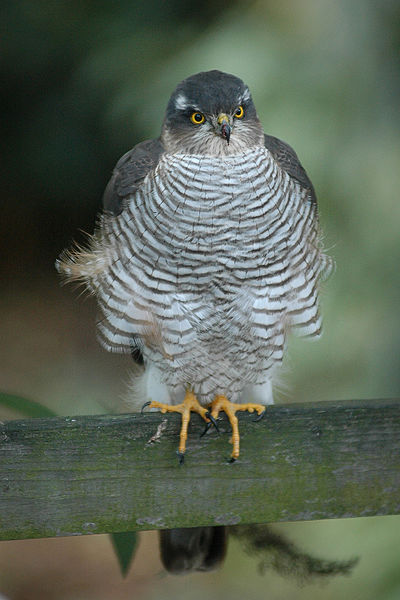Eurasian Sparrowhawk Bird Details
Accipiter nisus
Eurasian Sparrowhawk,Northern Sparrowhawk, Sparrowhawk;
Bashin, Basha
Linnaeus (1758)
Accipitriformes (HAWKS, EAGLES and KITES)
Accipitridae
Accipiter
United Kingdom, most of Europe, parts of Russia, North Africa, Central and South Asia, India.
Appearance :
Males have bluish-grey upperparts with orange-barred underparts. Females and juveniles are brown with dark streaks below.
Behaviour :
Known for agile hunting, typically ambushing small birds in flight. Rapid wing beats followed by short glides; capable of fast, maneuverable flight. Monogamous during the breeding season. Builds nests in trees.
Habitat :
Woodland areas, forests, parks, and sometimes gardens. Nests are often found in trees within forests, woodlands, or nearby open fields.
Diet :
Primary Diet: Small birds such as sparrows, finches, and tits. Occasionally: Small mammals, insects, and reptiles.
Conservation Status :
Least Concern
Distribution :
Found across much of the temperate and subtropical parts of Eurasia, from Europe and North Africa to parts of South Asia.
Population Size :
Between 1-2 million mature individuals globally.
Life Span :
4-7 years in the wild, though some can live up to 10-15 years.
Body And Tarsus:
- Body: The Eurasian Sparrowhawk has a compact, streamlined body, designed for agility and speed, particularly for catching small birds in flight. Females are noticeably larger than males (sexual dimorphism).
- Tarsus Length: The tarsus (the lower leg portion) is slender and typically measures between 4.2 to 5.3 cm. It is adapted for gripping and catching prey.
Head And Bill :
- Head: Rounded head with keen eyesight, featuring a sharp, forward-facing gaze suited for hunting.
- Bill: Hooked and sharp, typical of birds of prey, used for tearing meat.
- Bill Length: The bill length is relatively short, approximately 1.5-1.8 cm.
Length :
Males: 29–34 cm. Females: 35–41 cm.
Neck :
Short and sturdy, allowing for swift head movements while tracking or handling prey.
Size :
Male: Smaller, more agile. Female: Larger, more powerful, can handle larger prey than males.
Tail Details :
- Tail: Long and rounded at the tip, which helps in quick, agile turns during flight.
- Tail Length: Ranges from 16–22 cm depending on the individual and sex.
- Feathers: The upperparts of males are bluish-grey, while females are brown with dark streaks. Underparts are barred in both sexes (orange for males, brown for females).
Weight :
Males: 110–196 grams. Females: 185–342 grams.
Wing :
Broad and rounded wings, which enable short bursts of speed and agility during hunts.
Wing Span :
Males: 58–65 cm. Females: 67–80 cm.
Facial Feature :
Large, forward-facing yellow or orange eyes. Beak is small, sharply hooked for tearing flesh. The fleshy area at the base of the beak is yellow or orange.
Nest Details :
- Nest: The nest is built by both the male and female in the fork of a tree, often well-hidden within dense woodland or forested areas. Males usually collect materials, while females shape the nest.
- Nest Made up of: The nest is constructed mainly from twigs and small branches, lined with softer materials like leaves or bark strips.
Breeding Season :
The breeding season typically starts in late spring to early summer. In Europe, breeding can occur from April to June.
Nesting Season :
Nesting usually begins in April, with eggs laid in May or June.
Egg Color :
Eggs are typically bluish-white with brown or reddish speckles.
Egg Length :
Approximately 36–41 mm.
Egg Width and Weight :
- Egg Width: Around 29–32 mm.
- Egg Weight: Each egg weighs approximately 17-19 grams.
Clutch Size :
A typical clutch consists of 3 to 6 eggs, though 4 or 5 eggs are most common.
No. of Broods :
1 brood per year is typical, though a second brood may occasionally be attempted in optimal conditions.
Incubation Period :
The incubation lasts for about 32–35 days
Nestling Period :
The chicks remain in the nest for about 24–30 days before fledging
Vocalization :
Soft “kek-kek-kek” or “chip-chip-chip” sounds, especially during the breeding season.
Sex Demorphism :
Male: Smaller, with bluish-grey upperparts and orange-brown barring below. Female: Larger, with brown upperparts and less vivid barring, and overall more streaking below.
Migration Details :
Type: Partial migratory species. Northern populations tend to migrate, while southern populations remain resident.
Migration Period: Autumn migration occurs from September to November. Spring migration takes place from March to May.
Migration Route: Birds from northern Europe and western Russia migrate southward to warmer climates, including southern Europe, North Africa, and parts of Asia. They may cross the Mediterranean Sea during migration.

